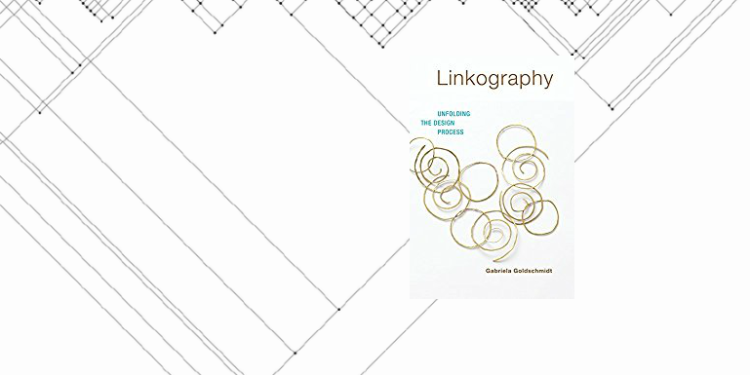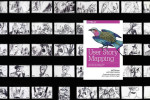Design Moves

Linkography: Unfolding the Design Process by Gabriela Goldschmidt
Linkography seeks to unravel and explain the design process by creating standardized maps of the process that designers use to arrive at a solution to a design challenge. After reading Christopher Alexander’s Notes on the Synthesis of Form, Goldschmidt realized that “designing can be clarified–that there is a logic to it, and that it is not pure magic.” Linkography is essentially a notation system to record decisions and activities that occur during a design work session.
The book begins with a discussion of design as it was conceived of by Christopher Alexander–“a rational process wherein a problem is decomposed into subsets.” In this view, the designer’s role is to “remove any misfits among responses to the subsets.” Good design is measured by the fit between the problem and the solution.
Design synthesis
Goldschmidt then introduces the concept of a design synthesis which is “an idea, a concept or a selection of ideas or concepts that can be used to support a comprehensive, coherent design solution.” The design synthesis relies on the congruence (“good fit”) of the individual design activities. Linkography concerns itself with the individual design activities that are made as designers work together to create a solution. Goldschmidt calls these small design activities (generating ideas, analyzing them, and adjusting them) “design moves”. Linkographs are maps of the relationships between these activities over time as they build towards the final design. Divergent and convergent thinking modes become evident when the network map of design moves is revealed. “Critical moves” are design decisions that are pivotal with respect to the final solution. They consolidate previous thinking and spawn lines of thought which ultimately lead to the design which emerges at the end of the process.
The Science of Design
Goldschmidt says that after World War II, there was an increased demand for design skills to repair damage in Europe and manage the expanding suburban US landscape. She says “practitioners everywhere felt unprepared for the challenges of designing large neighborhoods, entire new towns, and expansive road systems.” With the growth of design disciplines came an interest in systematizing, understanding and describing design thinking.
One of the first movements to understand design was Design Methods. In Design Methods, “design was seen as problem solving” and “a logical process, one controlled by rules that could be explicated and prescribed.” Included in this perspective was the assumption that design was a science and was learnable and teachable. The systematic process at the core of Design Methods thinking was a three-step process of analysis, synthesis, and evaluation (ASE) first published in 1962. Requirements and objectives are determined first, then data is gathered. Analysis of constraints, opportunities and tradeoffs is then conducted. During synthesis, the best solution is chosen. Finally, after more detail is added, the design is evaluated and presented to others for assessment. An elaboration of ASE resulted in a spiral process which proceeded iteratively through the levels and moved from abstract to concrete. Design Methods viewed any artistic element of design as antithetical to its nature and purpose.
Christopher Alexander responded to the Design Methods perspective by asserting that decomposition into smaller problems was the only way to solve complex design problem. There was no other method for simplification. Alexander noted that in un-self conscious cultures, there is no discipline of design and no theories of design. There is a “right” way of doing things that is embedded in tradition and does not vary over time. In self conscious cultures, design is a profession and there is a translation between description and execution. Managing the “requirements” process and communication between performing parties becomes an important activity.
As the conversation continued, the pendulum swing back towards “intuitive” design thinking. As more attempts were made to understand the design process, “it turned out that, in fact, very little was known about how designers think and, in particular, how they generate and develop ideas.” Cognitive psychology was then brought to bear on the subject. With the emphasis on the mind, humans were seen as “active processors of symbolic information.” The investigation of the design thinking now turned to “empirical studies based on actual real-life evidence” and resulted in protocol analysis.
Protocol Analysis
Protocol analysis is “a rigorous methodology for eliciting verbal reports of thought sequences as a valid source of data on thinking.” In protocol analysis, a designer (the subject of the analysis) will “think aloud” and describe each design-related thought and decision as it occurs. One problem with the method is that not all thought is available to consciousness and verbalization. Moreover, speaking can alter one’s perception and individuals are not always objective about their own thought processes. To resolve some of these challenges, a coding system was created in order to capture the subject’s thoughts more objectively and standardize notes across various researchers. Goldschmidt provides a detailed analysis of protocol analysis as it contains the seeds of linkography.
Design Synthesis
Good ideas at the front edge will lead to a successful results, whereas ideas of lesser quality may well result in less successful outcomes…Therefore it is of crucial importance that the search at the front edge should yield the best possible ideas.
Linkography maps the early phase of design because what happens here is so critical to the final outcome.
…the quality and the creativity of the design process depend on the designer’s ability to synthesize a solution that exhibits a good fit among all its components. The solution must respond to a large number of requirements and desires; beyond that, a creative solution is expected to be novel and exciting.
Goldschmidt’s research with linkography has shown that “links among ideas (decisions, moves) are of great importance in the cognitive processes involved in searching for successful solutions to design problems”, a conclusion which she says “is by no means obvious or trivial”. Critical moves in the design process are defined by the number of links to other ideas. Linkography also proposes that creative processes are the result of networks of related design moves.
the most crucial thing in a design process is the solidification of a major idea, or combination of ideas, that could bring together all major aspects the design had to respond to…in other words, synthesis or integration was the major goal of conceptual design
The fundamental premise of linkography is that successful design is achieved through cycles of divergent and convergent thinking that ensure continuity with past ideas while simultaneously moving forward with new ideas. Linkographs enable design researchers to determine whether a designer is maintaining consistency and integrity with previous and future design components. Goldschmidt says that “intense interlinking among design ideas is a perquisite for creativity.” To to this, a designer has to “acquire a mode of thinking whereby frequent propositions are immediately followed by evaluative steps that make sure that the design holds together at every moment.”
it is not enough to have ideas, even many ideas; the ideas have to be good, and to be good they must be perfectly integrated and interlinked
Linkography is a process for breaking down the design process into “moves”. These individual decisions, ideas, and statements are then plotted with an emphasis on connections with prior and future moves. Each linkography reveals common patterns which can be used to understand pivotal events within the process of arriving at a final design solution.
Goldschmidt writes “the fundamental premise underlying linkography theory…is that the quality and the creativity of a design process depend on the designer’s ability to synthesize a solution that exhibits a good fit among all its components.” This synthesis is achieved by “interlinking the very small design steps called moves that are made in the process of designing.”
The book begins with a history of design thinking research and the various theories and lines of investigation seeking to understand how design works and how decisions are made during design activities. Goldschmidt then describes several examples of design processes in detail and shows how the design team’s process is captured in linkographs.







